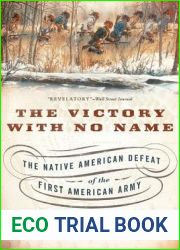
BOOKS - The Victory with No Name: The Native American Defeat of the First American Ar...

The Victory with No Name: The Native American Defeat of the First American Army
Author: Colin G. Calloway
Year: January 1, 2014
Format: PDF
File size: PDF 3.7 MB
Language: English

Year: January 1, 2014
Format: PDF
File size: PDF 3.7 MB
Language: English

The Victory with No Name: The Native American Defeat of the First American Army In 1791, General Arthur St. Clair led the United States army in a campaign to destroy a complex of Indian villages at the Maumee River in northwestern Ohio. Almost within reach of their objective, St. Clair's 1400 men were attacked by about one thousand Indians. The US force was decimated, suffering nearly one thousand casualties in killed and wounded, while Indian casualties numbered only a few dozen. Despite the lopsided result, it wouldn't appear to carry much significance - it involved only a few thousand people, lasted less than three hours, and the outcome, which was never in doubt, was permanently reversed just three years later. However, as renowned Native American historian Colin Calloway demonstrates in his book "The Victory with No Name this battle was hugely important for its time. It was both the biggest victory the Native Americans ever won and proportionately the biggest military disaster the United States had suffered. The defeat threatened the very existence of the infant United States, generating a deluge of reports, correspondence, opinions, and debates in the press. It produced the first congressional investigation in American history and ultimately changed not only the manner in which Americans viewed, organized, and paid for their armies but the very ways in which they fought their wars.
The Victory with No Name: The Native American Defeat of the First American Army В 1791 году генерал Артур Сент-Клер возглавил армию США в кампании по уничтожению комплекса индейских деревень у реки Мауми на северо-западе штата Огайо. Почти в пределах досягаемости от цели 1400 человек Сент-Клера были атакованы примерно одной тысячей индейцев. Американские силы были уничтожены, понеся почти тысячу потерь убитыми и ранеными, в то время как индийские потери составили всего несколько десятков человек. Несмотря на однобокий результат, он, похоже, не будет иметь большого значения - в нем приняли участие всего несколько тысяч человек, он длился менее трех часов, и результат, который никогда не вызывал сомнений, был навсегда отменен всего три года спустя. Однако, как демонстрирует в своей книге «Победа без имени» известный индейский историк Колин Кэллоуэй, эта битва имела огромное значение для своего времени. Это была и самая большая победа, которую когда-либо одерживали коренные американцы, и пропорционально самая большая военная катастрофа, которую потерпели Соединенные Штаты. Поражение поставило под угрозу само существование младенческих Соединенных Штатов, породив поток отчетов, переписки, мнений и дебатов в прессе. Это было первое расследование Конгресса в американской истории и в конечном итоге изменило не только то, как американцы смотрели на свои армии, организовывали их и платили за них, но и то, как они вели свои войны.
The Victory with No Name : The Native American Defeat of the First American Army En 1791, le général Arthur St. Clair a dirigé l'armée américaine dans une campagne pour détruire un complexe de villages indiens près de la rivière Maumi, dans le nord-ouest de l'Ohio. Près d'un millier d'Indiens ont été attaqués par les hommes 1400 de St. Clair. s forces américaines ont été détruites, causant près d'un millier de morts et de blessés, tandis que les pertes indiennes n'étaient que de quelques dizaines. Malgré un seul résultat, il ne semble pas avoir beaucoup d'importance - seulement quelques milliers de personnes y ont participé, il a duré moins de trois heures, et le résultat, qui n'a jamais fait de doute, a été définitivement annulé trois ans plus tard. Cependant, comme le montre le célèbre historien indien Colin Calloway dans son livre « Une victoire sans nom », cette bataille a eu une grande importance pour son époque. C'était la plus grande victoire jamais remportée par les Amérindiens et proportionnellement la plus grande catastrophe militaire que les États-Unis aient subie. La défaite a mis en péril l'existence même des jeunes États-Unis en créant un flot de rapports, de correspondance, d'opinions et de débats dans la presse. C'était la première enquête du Congrès dans l'histoire américaine et a finalement changé non seulement la façon dont les Américains regardaient leurs armées, les organisaient et les payaient, mais aussi la façon dont ils menaient leurs guerres.
The Victory with No Name: The Native American Defeat of the First American Army En 1791, el general Arthur St. Clair dirigió al Ejército de los Estados Unidos en una campaña para destruir un complejo de aldeas indias cerca del río Maumi en el noroeste del estado Ohio. Casi al alcance del objetivo, los 1.400 hombres de St. Clair fueron atacados por unos mil indios. fuerzas estadounidenses fueron destruidas, sufriendo casi un millar de bajas entre muertos y heridos, mientras que las bajas indias fueron sólo unas pocas decenas de personas. A pesar del resultado deslucido, no parece que vaya a importar mucho - solo participaron unos pocos miles de personas, duró menos de tres horas y el resultado, que nunca había sido cuestionable, fue cancelado para siempre apenas tres después. n embargo, como demuestra el famoso historiador indio Colin Calloway en su libro «La victoria sin nombre», esta batalla tuvo una enorme importancia para su tiempo. Esta fue también la mayor victoria que los nativos americanos hayan ganado, y proporcionalmente la mayor catástrofe militar que han sufrido los Estados Unidos. La derrota puso en peligro la existencia misma de los Estados Unidos infantes, generando un aluvión de informes, correspondencia, opiniones y debates en la prensa. Fue la primera investigación del Congreso en la historia estadounidense y finalmente cambió no solo la forma en que los estadounidenses miraban a sus ejércitos, los organizaban y pagaban por ellos, sino también la forma en que libraban sus guerras.
The Victory with No Name: The Native American Defeat of the First American Army Em 1791, o general Arthur St Clare liderou o exército dos EUA na campanha para destruir um complexo de aldeias indígenas perto do Rio Maumi, no noroeste de Ohio. Quase ao alcance do alvo 1400 homens de St. Claire foram atacados por cerca de mil índios. As forças americanas foram destruídas, com quase mil mortos e feridos, enquanto as baixas indianas foram de apenas algumas dezenas. Apesar do resultado homólogo, ele parece não ter grande importância - apenas alguns milhares de pessoas participaram, durou menos de três horas, e o resultado, que nunca era duvidoso, foi cancelado para sempre apenas três anos depois. No entanto, como demonstrou em seu livro «Vitória sem Nome», o famoso historiador indígena Colin Calloway, a batalha foi muito importante para o seu tempo. Esta foi a maior vitória que os nativos americanos já obtiveram e proporcionalmente a maior catástrofe militar que os Estados Unidos sofreram. A derrota comprometeu a própria existência de crianças dos Estados Unidos, gerando relatórios, correspondências, opiniões e debates na imprensa. Esta foi a primeira investigação do Congresso na história americana e acabou mudando não só a forma como os americanos olhavam para os seus exércitos, organizavam-nos e pagavam por eles, mas também a forma como eles faziam as suas guerras.
The Victory with No Name: The Native American Defeat of the First American Army Nel 1791 il generale Arthur St. Claire guidò l'esercito americano nella campagna di distruzione di un complesso di villaggi indiani vicino al fiume Maumi, nel nord-ovest dell'Ohio. Quasi alla portata dell'obiettivo 1400 uomini di St. Claire sono stati attaccati da circa un migliaio di indiani. forze americane sono state distrutte, con quasi mille morti e feriti, mentre le vittime indiane erano solo poche decine. Nonostante il risultato uninominale, non sembra importare molto - ha partecipato solo poche migliaia di persone, è durato meno di tre ore e il risultato, che non ha mai avuto dubbi, è stato cancellato per sempre solo tre anni dopo. Tuttavia, come dimostra il noto storico indiano Colin Calloway nel suo libro «Vittoria senza nome», questa battaglia è stata di grande importanza per il suo tempo. È stata la più grande vittoria mai ottenuta dai nativi americani e proporzionalmente il più grande disastro militare che gli Stati Uniti abbiano subito. La sconfitta ha messo in pericolo l'esistenza stessa degli Stati Uniti infantili, generando un flusso di rapporti, comunicazioni, opinioni e dibattiti di stampa. Fu la prima indagine del Congresso nella storia americana e alla fine cambiò non solo il modo in cui gli americani guardavano i loro eserciti, li organizzavano e li pagavano, ma anche il modo in cui gestivano le loro guerre.
The Victory with No Name: The Native American Defeat of the First American Army 1791 führte General Arthur St. Clair die US-Armee in einer Kampagne zur Zerstörung des Indianerdorfkomplexes am Maumee River im Nordwesten von Ohio. Fast in Reichweite des Ziels wurden 1400 St. Clair-ute von etwa tausend Indianern angegriffen. Die amerikanischen Streitkräfte wurden zerstört und erlitten fast tausend Tote und Verwundete, während die indischen Verluste nur ein paar Dutzend Menschen betrugen. Trotz des einseitigen Ergebnisses scheint es keine große Sache zu sein - nur ein paar tausend Menschen nahmen daran teil, es dauerte weniger als drei Stunden und das Ergebnis, das nie in Frage stand, wurde nur drei Jahre später für immer abgesagt. Doch wie der berühmte indische Historiker Colin Calloway in seinem Buch „Victory Without a Name“ zeigt, war dieser Kampf für seine Zeit von großer Bedeutung. Es war sowohl der größte eg, den die amerikanischen Ureinwohner je errungen haben, als auch im Verhältnis dazu die größte militärische Katastrophe, die die Vereinigten Staaten erlitten haben. Die Niederlage gefährdete die Existenz der Säuglingsstaaten der Vereinigten Staaten und erzeugte eine Flut von Berichten, Korrespondenzen, Meinungen und Debatten in der Presse. Dies war die erste Untersuchung des Kongresses in der amerikanischen Geschichte und veränderte letztendlich nicht nur die Art und Weise, wie die Amerikaner ihre Armeen betrachteten, sie organisierten und für sie bezahlten, sondern auch die Art und Weise, wie sie ihre Kriege führten.
''
İsimsiz Zafer: İlk Amerikan Ordusunun Kızılderili Yenilgisi 1791 yılında General Arthur St. Clair, kuzeybatı Ohio'daki Maumee Nehri yakınlarındaki bir Hint köyü kompleksini yok etmek için ABD Ordusu'na liderlik etti. Hedefin menziline giren St. Clair'in 1.400 adamı yaklaşık bin Kızılderili tarafından saldırıya uğradı. Amerikan kuvvetleri yok edildi, neredeyse bin kayıp verdi ve yaralandı, Kızılderili kayıpları ise sadece birkaç düzine insana ulaştı. Orantısız sonuca rağmen, çok fazla fark yaratacağa benzemiyor - sadece birkaç bin kişi katıldı, üç saatten az sürdü ve sonuç asla şüphe duymadı, sadece üç yıl sonra kalıcı olarak iptal edildi. Bununla birlikte, ünlü Hintli tarihçi Colin Calloway'in kitabında gösterdiği gibi İsimsiz Zafer, bu savaş zamanı için büyük önem taşıyordu. Hem Amerikan yerlilerinin kazandığı en büyük zafer hem de orantılı olarak ABD'nin yaşadığı en büyük askeri felaketti. Yenilgi, bebek Amerika Birleşik Devletleri'nin varlığını tehdit etti ve basında bir rapor, yazışma, görüş ve tartışma seli yarattı. Bu, Amerikan tarihindeki ilk kongre soruşturmasıydı ve nihayetinde sadece Amerikalıların ordularına nasıl baktıklarını, örgütlendiklerini ve ödeme yaptıklarını değil, aynı zamanda savaşlarını nasıl yürüttüklerini de değiştirdi.
النصر بدون اسم: هزيمة الأمريكيين الأصليين للجيش الأمريكي الأول في عام 1791، قاد الجنرال آرثر سانت كلير الجيش الأمريكي في حملة لتدمير مجمع من القرى الهندية بالقرب من نهر مومي في شمال غرب ولاية أوهايو. في نطاق الهدف تقريبًا، تعرض رجال سانت كلير البالغ عددهم 1400 لهجوم من قبل حوالي ألف هندي. تم تدمير القوات الأمريكية، مما أدى إلى مقتل وجرح ما يقرب من ألف شخص، بينما بلغت الخسائر الهندية بضع عشرات فقط من الأشخاص. على الرغم من النتيجة غير المتوازنة، لا يبدو أنها ستحدث فرقًا كبيرًا - فقط بضعة آلاف من الأشخاص شاركوا، واستمرت أقل من ثلاث ساعات، وتم إلغاء النتيجة، التي لم تكن موضع شك أبدًا، بشكل دائم بعد ثلاث سنوات فقط. ومع ذلك، كما يوضح المؤرخ الهندي الشهير كولين كالواي في كتابه النصر بدون اسم، كانت هذه المعركة ذات أهمية كبيرة لوقتها. كان هذا أكبر انتصار حققه الأمريكيون الأصليون على الإطلاق وأكبر كارثة عسكرية عانت منها الولايات المتحدة بشكل متناسب. هددت الهزيمة وجود الولايات المتحدة الرضيعة، مما أدى إلى فيض من التقارير والمراسلات والرأي والنقاش في الصحافة. كان هذا أول تحقيق للكونغرس في التاريخ الأمريكي وغير في النهاية ليس فقط كيف نظر الأمريكيون إلى جيوشهم ونظموها ودفعوا ثمنها، ولكن أيضًا كيف خاضوا حروبهم.














